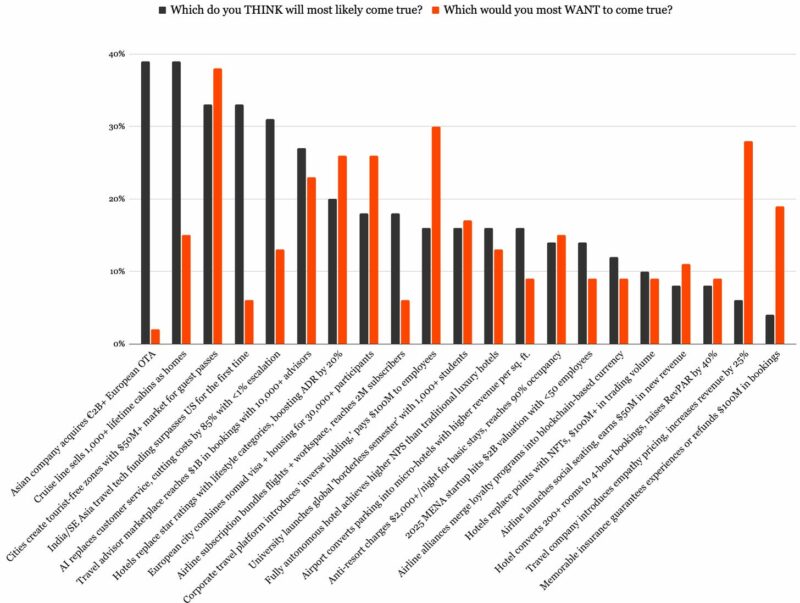
The market situation is constantly changing. Competitors have just lowered their rates, there’s a significant event bringing group business to the city next month, and guest booking patterns are shifting unpredictably. Unsurprisingly, many revenue managers are always trying to catch up. The complexity is real and can affect both productivity and morale. When you spend most of your day juggling spreadsheets, software platforms, and urgent last-minute decisions, there’s little time left for strategic thinking or proactive planning.
The Promise of a New Approach
But it doesn’t have to be this way. You can transform your work by looking back at your role through a new lens—one structured around four key pillars. These pillars are:
- Streamline – Eliminate cluttered processes, reduce manual tasks, and adopt a simpler, more efficient workflow.
- Clarity—Gain a clear understanding of your priorities and goals, and make decisions with a focused mind.
- Confidence – Empower yourself and your team to rely on data-backed insights and strategic thinking.
- Freedom—Once you’re out of the daily grind, you can explore broader revenue opportunities, such as ancillary services and cross-departmental collaborations.
By embracing these four concepts, you’ll break free from the hamster wheel of daily reactive tasks and become more strategic. Whether you’re a seasoned revenue manager or someone new to the field, developing a systematic, forward-thinking approach can reduce stress, increase productivity, and ultimately improve your hotel’s bottom line.
In the following sections, we’ll dive into these pillars—starting with Streamlining—to show you how to reclaim your time, enhance your decision-making, and transform your day-to-day from chaotic to composed.
1. Streamline: Building a System That Works for You
Consolidate Your Tools & Systems
One of the biggest time drains for revenue managers is managing data across multiple platforms—PMS, CRS, channel managers, and even Excel spreadsheets. When your data lives in different silos, you spend more time chasing information than analyzing it. By consolidating these disparate sources into one integrated platform, you instantly remove a significant obstacle to efficiency. A hotel business intelligence tool eliminates the tedium of manually combining reports and reduces the chances of overlooking essential trends because the data isn’t all in one place.
The ultimate goal is to free up your time and mental energy. Instead of wrestling with multiple logins and copying data into spreadsheets, you can focus on higher-value activities like analyzing demand patterns or planning strategic promotions. Reporting becomes seamless when everything from your PMS to your distribution channels is visible on a single dashboard. Business intelligence enables real-time insights that guide faster, more accurate decision-making.
Automate Where Possible
Automation is another powerful way to lighten the load. Modern business intelligence systems can automate tasks such as pulling daily pickup reports, benchmarking competitor rates, or updating rate shops. Rather than waiting for a weekly update or manually crunching numbers, you can schedule these tasks to run at set intervals—daily, hourly, or even in real-time.
The benefits are twofold. First, automation saves hours of manual labor, so repetitive tasks don’t swallow up your day. Second, automated processes lower the risk of human error—no more missed updates or typos that lead to inaccurate pricing decisions. As a result, you’ll have more consistent, reliable data at your fingertips and the peace of mind that comes with knowing the basics are taken care of.
Lean Processes to Maximize Efficiency
Finally, it’s worth taking a holistic look at your day-to-day processes to see where to trim the excess. Conduct a thorough process audit to identify repetitive tasks that add minimal value. For example, you might automate report reconciliation or simplify a multi-step approval process.
Once pinpointing these inefficiencies, decide whether they can be eliminated, automated, or delegated. If a task doesn’t require your specialized expertise, consider handing it off to someone on your team—or even to an outsourced service—so you can focus on the strategic decisions that truly move the needle. By systematically removing time-intensive, low-yield activities, you’ll create a streamlined operational flow that empowers you to work more proactively instead of constantly playing catch-up.
2. Clarity: Setting a Clear Path Forward
Defining Your Revenue Goals
Every great revenue strategy begins with a clear set of objectives. Ask yourself: What are we trying to achieve—higher occupancy, increased ADR, more ancillary spending, or a better guest mix? Aligning these goals with the hotel’s larger business objectives allows you to prioritize your efforts and ensure your strategies are moving in the right direction.
When these goals are well-defined and communicated across the organization, each department can rally around them. For instance, a clear revenue target might inform marketing on how to shape promotions, guide sales in group business negotiations, and help operations prepare staffing needs. Clarity in your goals streamlines decision-making and unifies the team’s day-to-day focus.
Creating a Roadmap to Success
Once you establish your objectives, you need a roadmap that outlines your plan to achieve them. Consider mapping out key initiatives and timelines, such as conducting monthly forecasting, reviewing pricing structures every quarter, or launching a marketing campaign during low-demand periods. This roadmap serves as a guiding document, helping all stakeholders understand what to expect and when to expect it.
Accountability is crucial. Assign clear responsibilities for each task and establish weekly or monthly checkpoints to track progress. These regular check-ins ensure that minor issues don’t go unnoticed and can be corrected before they escalate into more significant problems. Breaking down larger goals into manageable steps creates a steady rhythm that keeps the team aligned and motivated.
Visualizing Data for Better Insights
Revenue management is a data-intensive discipline, and the best way to transform raw numbers into actionable insights is through effective visualization. Dashboards, scorecards, and color-coded reports allow you to grasp key metrics—pace, pickup, and market segmentation—at a glance. Rather than sifting through lengthy spreadsheets, you can use a business intelligence tool to spot patterns and trends quickly, freeing up time for deeper strategic thinking.
Visualizing data can illuminate opportunities beyond spotting problems. For example, a well-designed report might highlight underperforming room types or show that a specific segment has unexpectedly high booking momentum. Identifying quick wins early can give you a competitive edge in a constantly changing market. By pairing clear goals with informative visuals, you’ll stay ahead of the curve and be ready to pivot as market conditions evolve.
3. Confidence: Empowered Decisions Backed by Data
Rely on Forecasting and Scenario Planning
Confidence in revenue management often hinges on the quality of your forecasts. A forecast that accurately captures upcoming demand allows you to make data-driven pricing, inventory, and marketing allocation decisions. To enhance forecasting accuracy, lean on both historical data and real-time market inputs:
- Historical Data: Analyze past performance and seasonal patterns to establish a baseline.
- Current Market Trends: Monitor macroeconomic indicators, competitor moves, and local events that may impact demand.
- Events & Special Occasions: Identify how conferences, concerts, or holidays affect your region and incorporate these factors into the forecast.
In addition to a standard forecast, consider scenario planning. By modeling different demand and pricing scenarios—such as “best-case,” “worst-case,” or “most likely,” for example—you can prepare flexible strategies for each potential outcome. This proactive approach helps you avoid unpleasant surprises and pivot quickly when the market shifts.
Collaborate and Align With Other Departments
Revenue management doesn’t work in isolation. Gaining support and buy-in from sales, marketing, and F&B teams is crucial for making confident and effective decisions. Involving these departments in revenue meetings and sharing data-driven insights fosters a culture of transparency and collaboration.
- Sales Teams: Provide them with clear rate guidance and pace data so they can negotiate effectively with corporate and group clients.
- Marketing: Align your campaigns with upcoming low-demand periods or need dates to maximize return on ad spend.
- Food & Beverage (F&B): Inform your F&B teams about expected occupancy spikes to optimize staffing, menus, and promotions accordingly.
When all stakeholders understand how their actions affect the hotel’s overall profitability, it’s much easier to reach a consensus on key decisions, such as offering promotional rates or launching a bundled package. Unified decision-making fosters a sense of shared responsibility and boosts confidence across the entire organization.
Trusting the Numbers, Trusting Your Gut
While data is your most reliable compass, if you use a modern hotel business intelligence system, there’s room for intuition and industry experience. Revenue managers bring invaluable expertise—understanding guest behavior, market nuances, and the hotel’s brand identity. Combining these insights with data-driven analysis leads to more nuanced, effective decisions.
Moreover, it encourages a culture of agility and experimentation. If a rate strategy isn’t delivering the expected results, don’t be afraid to change course. The market can shift swiftly due to sudden competitor moves or unexpected local events. By trusting both the numbers and your market instincts—and remaining willing to pivot when necessary—you’ll continually sharpen your revenue management strategies and maintain the confidence needed to steer your property toward success.
4. Freedom: Exploring New Opportunities (Total Revenue Management)
Expand Beyond Rooms
Freedom in revenue management isn’t just about having more time in your day—it’s also about exploring new profit avenues. While rooms are often the primary focus, there’s significant untapped potential in other areas of your hotel. When managed strategically, food & beverage, meetings and events, spa services, parking, and retail outlets can generate substantial revenue.
To maximize these opportunities, consider tracking metrics beyond the usual RevPAR. Total revenue metrics like TRevPAR (Total Revenue per Available Room) and Total Spend per Guest paint a more holistic picture of a property’s performance. By looking at how each revenue stream contributes to the bottom line, you can uncover hidden profit centers and develop cross-selling or upselling strategies that might otherwise go unnoticed.
Break Down Silos
Achieving proper total revenue management requires buy-in from every revenue-generating department. To move beyond isolated decision-making in rooms, you need a business intelligence tool to share information and create a holistic approach that includes F&B, events, and other teams. When all departments share information—from expected occupancy and guest demographics to historical spending patterns—every arm of the hotel can align on pricing, staffing, marketing, and promotional initiatives.
- Open Communication: Hold regular meetings where each team shares their upcoming plans and current performance metrics.
- Shared Systems and Dashboards: To prevent siloed thinking, use a business intelligence tool to provide visibility into real-time data for every department.
When departments work together to optimize the guest’s total experience, you elevate guest satisfaction and overall profitability. This synergy also fosters a culture of innovation, where all teams feel empowered to propose revenue-generating ideas.
Future-Proof the Operation
“Freedom” in revenue management also means having the flexibility to adapt to whatever the market might throw your way. Technological advances—like dynamic packaging, upselling tools, and personalized marketing—rapidly change how hotels interact with guests and manage inventory. Proactively exploring and adopting these innovations will keep your hotel ahead of the curve.
- Dynamic Packaging: To customize guests’ stays, bundle rooms with value-added services, such as spa treatments or dinner reservations.
- Upselling & Personalization Tools: Use predictive analytics to recommend room upgrades or add-on experiences tailored to individual preferences.
- Evolving Guest Preferences: Monitor consumer trends—such as health and wellness travel or remote-work “bleisure” stays—and adjust your offerings accordingly.
Staying nimble in the face of new technology and shifting guest expectations safeguards your hotel’s long-term relevance and expands your revenue growth horizons. Embracing total revenue management is more than boosting numbers on the balance sheet—it’s about creating a profitable, guest-centric hotel experience ready for whatever comes next.
Conclusion
The Evolution of the Revenue Manager’s Role
Hotel revenue management has progressed well beyond the days of reactive, day-to-day rate adjustments. Hotel companies expect today’s revenue managers to be strategic leaders who can interpret complex market data, anticipate guest preferences, and unify cross-departmental objectives. This evolution demands a shift in tactics—from purely reactive to proactive—and a commitment to ongoing learning. By staying informed about market trends, new technologies, and best practices, revenue managers can remain agile and continue to add value in an ever-changing industry.
Call to Action
Before you wrap up your day, take a step back and assess where you stand in the four pillars of Streamlining, Clarity, Confidence, and Freedom. What processes can you automate or simplify? Are your revenue goals aligned with broader business objectives? Have you built the confidence to make data-driven decisions quickly, and are you prepared to explore new revenue streams?
- Audit Your Current Practices: Identify inefficiencies, bottlenecks, and missed opportunities in your current workflow.
- Adopt an Integrated Platform: Use a hotel business intelligence tool to consolidate all your data sources under one roof, creating a single “source of truth” for informed decision-making.
- Share Success Stories: Collaborate with peers and industry experts, whether through professional communities, online forums, or conferences.
By actively engaging in continuous improvement, you will enhance your performance and contribute to a vibrant community of revenue professionals shaping the future of hospitality.
Key Takeaway
Remember the framework: Streamline your systems and processes, pursue Clarity with well-defined objectives, make data-driven decisions with Confidence, and gain the Freedom to innovate beyond rooms into total revenue management. Embracing these four pillars can help you transform your daily workload into a more strategic, insightful, and ultimately more rewarding role that pushes you and your hotel toward greater profitability and success.







